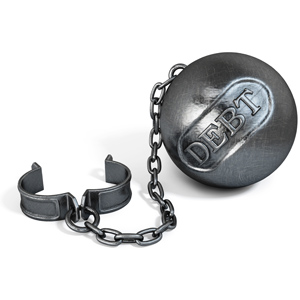6% of adults have debt from court costs or legal fees, Federal Reserve report says

Image from Shutterstock.com.
A Federal Reserve board survey on economic well-being has found that 6% of adults have debt from court costs or legal fees.
Among those with an immediate family member in jail or prison, the percentage with outstanding legal debt increases to 20%, according to a report on the fall 2019 survey.
It’s the first time the survey has included questions about repercussions of legal debt since the Federal Reserve board began taking the survey in 2013.
“Criminal convictions have been shown to result in difficulty finding future employment,” the report said. “Yet, an additional repercussion that has recently received attention is the effect of court costs and legal fees on people’s financial lives, in some cases, for years afterward.” The report is titled Report on the Economic Well-Being of U.S. Households in 2019.
The survey found that individuals whose family had outstanding legal expenses often had other types of debt as well.
Sixty-six percent also had credit card debt (compared to 44% of those with no outstanding legal expenses); 43% had medical debt (compared to 16% of those without legal expenses); and 26% had student loan debt (compared to 15% of those without legal expenses).
Legal debt also correlates with less access to credit and banking products.
Fifty-two percent had been denied credit, compared to 22% of those with no legal debt. Thirteen percent did not have a banking institution, compared to 5% of those with no legal debt. Only 48% had a bank account and fully used banking services, compared to 81% of those without legal debt.
Lauren-Brooke Eisen, director of the Justice Program at the Brennan Center for Justice, praised the Federal Reserve for recognizing the impact of fees and fines.
“The Federal Reserve is the definitive authority on economic conditions in the country,” Eisen said in a press release. “So the fact that they recognized that court costs and legal fees can affect American households, and for years after they incur these debts, is hugely significant.”
Eisen is one of the authors of the Brennan Center’s 2019 report, The Steep Costs of Criminal Justice Fees and Fines.
The Brennan Center report found that the high cost of collecting and enforcing fines is excluded from most assessments, meaning that actual revenues are lower than expected.
Counties studied in Texas and New Mexico effectively spent more than 41 cents of every dollar of revenue from fees and fines on court hearings and jail costs. That’s 121 times what the IRS spends to collect taxes.
See also:
The Marshall Project: “Coronavirus has not stopped many cash-strapped courts from seeking fines and fees”



